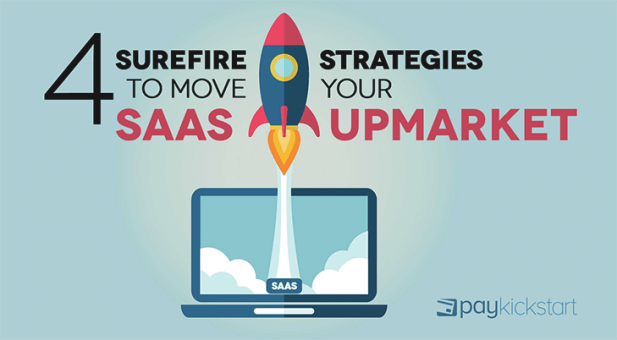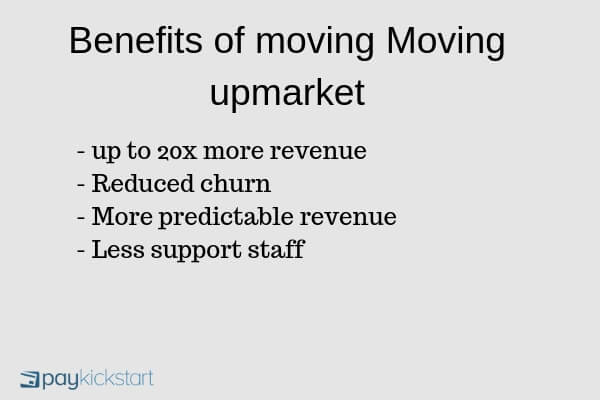Subscription growth hack (by PayKickstart)
Facebook Group - 3,932 members
Visit Group
Many founders start their saas business life by selling to SMBs because it’s what they know.
It’s where they’re comfortable.
Over time, you’ll notice some of the distinct challenges associated with SMBs such as higher average churn and little room for expansion revenue.
Those problems are reduced or eliminated when you move your saas upmarket. That’s why it becomes so attractive to companies when they’ve hit a ceiling or when they want to reach escape velocity.
In this article, I’ll look at a few strategies you can use to begin the process of moving your saas upmarket.
There are real risks associated with moving upmarket that you should be aware of before making the change.
Unless you’ve started out selling to enterprise customers from day one, you have a lot of small business customers. You’ve learned to serve their needs, market to them, and otherwise make them happy.
Your product roadmap is built around their needs and your development team has planned for specific features.
In other words, you’ve learned the ins and outs of your current customer segment. Moving upmarket is a serious pivot in your company.
You should be prepared to completely change the way you do acquisition, sales, and even the core features of your product.
If you go all in and the transition isn’t successful you have a product that’s not quite right for the SMB space but enterprise users don’t want.
What do you think happens next?
With that being said, the benefits are real.

I know the risks don’t scare you because you were brave enough to start a company. Compared to that, the risks of moving upmarket are minuscule.
The first strategy I’d like to point out doesn’t seem like a strategy at all. It’s just sound reasoning.
Wait for it.
In the words of Jason Lemkin
“If SMBs are your core, stay there, at least until $10m ARR. Do not chase customer segments where you have zero, or only token, traction. Not at $1m. It’s “too late”. You’ve already established your initial, organic customer traction and segmentation.”
$10m ARR seems like an arbitrary figure but the point he was trying to make is sound. You’re likely trying to move your saas upmarket too soon. At $1m ARR, you’re just starting to establish a real brand that gets customers without you lifting a finger.
From there, it continues to grow. You’re nowhere near saturation until you add more income. Wait until you’ve built in processes and have the resources to tackle the enterprise market correctly.
Who are your largest current customers? I mean the people who signed up for your largest plan then asked you to increase their limits.
Talk to them.
Find out what they want from you and why they were attracted to your solution in the first place.
Steli Efti of Close.io says it well:
Interview your five largest customers to find out why they chose you, what they value most about your solution, and what their biggest pain points with your product are. Validate there’s real market potential before you commit to move upmarket. Founders often underestimate how fundamentally they need to change their business in order to sell to the enterprise. They think it’s just a little adjustment in their sales and marketing strategy, but to really make the shift, the entire team needs to focus on serving enterprise customers.
Before you pivot your entire company, it’s worthwhile to run small experiments to see what works and what doesn’t.
That way, you’re able to keep your SMB customer base happy while you figure out what it’ll take to move your saas upmarket.
One of the fundamental differences between the enterprise and SMB’s is the number of stakeholders who’re involved. With a small business it’s the owner and his/her small team. You may talk to a single person if a conversation needs to happen – most of the time they don’t.
With true enterprise customers, you have legal teams, tech buyers, financial buyers, the end-user, marketing buyers, etc. It’s easy to drop the ball at any stage of this process because you’re inexperienced.
Take baby steps and experiment. It’s just like how you iterated when you were building your MVP and V1 of your product.
The same process will serve you well in your march upmarket.
The core of what makes an application enterprise ready is the level of support and managing multiple users.
Before you move your saas upmarket, you should have the bare minimum when it comes to features enterprise users expect.
While the specific features will vary depending on your product, some are standard across the board.
Just like in their organization, not everyone has access to all information. Inside your application, enterprise users will want to restrict access to certain aspects of the interface or add new users as the need arises.
Get ready for that and don’t make your prospects ask for it.
This goes without saying but I’ll say it anyways. The enterprise accounts you land will expect a higher level of support than the person paying you $29/m.
SSO is a major sticking point for large companies because no one wants to make a new username and password for 10 different applications. If you don’t have SSO then you can forget about enterprise sales. The funny thing is that it doesn’t matter one bit for individuals and smaller teams.
If your product is mission critical then be prepared to create and enforce a guaranteed uptime SLA. This let’s people know what they can expect from you in terms of availability. It matters. If your guarantee is too low then enterprise customers will pass.
The draw of enterprise customers (and revenue) can be too good to let go so founders decide to move their saas upmarket.
Sometimes, they realize too late that it’s a completely new set of challenges. We’ve looked at a few strategies you can employ to move upmarket successfully such as
Let me know what you think about moving saas upmarket and don’t forget to share.
Daniel Ndukwu is a regular contributor to the PayKickstart blog. He has extensive experience with online businesses, conversion optimization, and subscription revenue models. When he's not writing insightful content, he works with other entrepreneurs to help them grow their bottom line.
Read More About Daniel Ndukwu